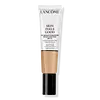Lancôme Skin Feels Good Tinted Moisturizer with SPF 23 Versus bareMinerals Complexion Rescue Tinted Hydrating Gel Cream
What's inside
What's inside
 Key Ingredients
Key Ingredients

 Benefits
Benefits

 Concerns
Concerns

 Ingredients Side-by-side
Ingredients Side-by-side

Water
Skin ConditioningGlycerin
HumectantCaprylyl Methicone
Skin ConditioningEthylhexyl Methoxycinnamate
UV AbsorberPropanediol
SolventDimethicone
EmollientRosa Gallica Flower Extract
AstringentSorbitol
HumectantTriethoxysilylethyl Polydimethylsiloxyethyl Dimethicone
Skin ConditioningDimethicone/PEG-10/15 Crosspolymer
Sodium Chloride
MaskingSodium Citrate
BufferingSodium Hyaluronate
HumectantMoringa Oleifera Seed Extract
Skin ConditioningAlumina
AbrasiveDisodium EDTA
Disodium Phosphate
BufferingIsopropyl Titanium Triisostearate
EmollientPropylene Glycol
HumectantDipropylene Glycol
HumectantCitric Acid
BufferingBHT
AntioxidantTocopherol
AntioxidantPhenoxyethanol
PreservativeChlorphenesin
AntimicrobialParfum
MaskingIron Oxides
CI 77891
Cosmetic ColorantWater, Glycerin, Caprylyl Methicone, Ethylhexyl Methoxycinnamate, Propanediol, Dimethicone, Rosa Gallica Flower Extract, Sorbitol, Triethoxysilylethyl Polydimethylsiloxyethyl Dimethicone, Dimethicone/PEG-10/15 Crosspolymer, Sodium Chloride, Sodium Citrate, Sodium Hyaluronate, Moringa Oleifera Seed Extract, Alumina, Disodium EDTA, Disodium Phosphate, Isopropyl Titanium Triisostearate, Propylene Glycol, Dipropylene Glycol, Citric Acid, BHT, Tocopherol, Phenoxyethanol, Chlorphenesin, Parfum, Iron Oxides, CI 77891
Titanium Dioxide 6.2%
Cosmetic ColorantWater
Skin ConditioningCoconut Alkanes
EmollientPropanediol
SolventSqualane
EmollientTrehalose
HumectantIsostearic Acid
CleansingGlycerin
HumectantSilica
AbrasiveAgar
MaskingCaprylic/Capric Triglyceride
MaskingGlobularia Cordifolia Callus Culture Extract
Skin ConditioningSalicornia Herbacea Extract
Skin ConditioningMelilotus Officinalis Extract
AstringentCoco-Caprylate/Caprate
EmollientButylene Glycol
HumectantLauroyl Lysine
Skin ConditioningSodium Hyaluronate
HumectantSuccinoglycan
Skin ConditioningPolysorbate 60
EmulsifyingCellulose Gum
Emulsion StabilisingPolyglyceryl-4 Laurate/Succinate
Sorbitan Sesquiisostearate
EmulsifyingMagnesium Stearate
Cosmetic ColorantMagnesium Hydroxide
AbsorbentMagnesium Chloride
Potassium Chloride
Calcium Chloride
AstringentPotassium Sorbate
PreservativePhenoxyethanol
PreservativeTitanium Dioxide 6.2%, Water, Coconut Alkanes, Propanediol, Squalane, Trehalose, Isostearic Acid, Glycerin, Silica, Agar, Caprylic/Capric Triglyceride, Globularia Cordifolia Callus Culture Extract, Salicornia Herbacea Extract, Melilotus Officinalis Extract, Coco-Caprylate/Caprate, Butylene Glycol, Lauroyl Lysine, Sodium Hyaluronate, Succinoglycan, Polysorbate 60, Cellulose Gum, Polyglyceryl-4 Laurate/Succinate, Sorbitan Sesquiisostearate, Magnesium Stearate, Magnesium Hydroxide, Magnesium Chloride, Potassium Chloride, Calcium Chloride, Potassium Sorbate, Phenoxyethanol
 Reviews
Reviews

Ingredients Explained
These ingredients are found in both products.
Ingredients higher up in an ingredient list are typically present in a larger amount.
Glycerin is already naturally found in your skin. It helps moisturize and protect your skin.
A study from 2016 found glycerin to be more effective as a humectant than AHAs and hyaluronic acid.
As a humectant, it helps the skin stay hydrated by pulling moisture to your skin. The low molecular weight of glycerin allows it to pull moisture into the deeper layers of your skin.
Hydrated skin improves your skin barrier; Your skin barrier helps protect against irritants and bacteria.
Glycerin has also been found to have antimicrobial and antiviral properties. Due to these properties, glycerin is often used in wound and burn treatments.
In cosmetics, glycerin is usually derived from plants such as soybean or palm. However, it can also be sourced from animals, such as tallow or animal fat.
This ingredient is organic, colorless, odorless, and non-toxic.
Glycerin is the name for this ingredient in American English. British English uses Glycerol/Glycerine.
Learn more about GlycerinPhenoxyethanol is a preservative that has germicide, antimicrobial, and aromatic properties. Studies show that phenoxyethanol can prevent microbial growth. By itself, it has a scent that is similar to that of a rose.
It's often used in formulations along with Caprylyl Glycol to preserve the shelf life of products.
Propanediol is an all-star ingredient. It softens, hydrates, and smooths the skin.
It’s often used to:
Propanediol is not likely to cause sensitivity and considered safe to use. It is derived from corn or petroleum with a clear color and no scent.
Learn more about PropanediolSodium Hyaluronate is hyaluronic acid's salt form. It is commonly derived from the sodium salt of hyaluronic acid.
Like hyaluronic acid, it is great at holding water and acts as a humectant. This makes it a great skin hydrating ingredient.
Sodium Hyaluronate is naturally occurring in our bodies and is mostly found in eye fluid and joints.
These are some other common types of Hyaluronic Acid:
Learn more about Sodium HyaluronateWater. It's the most common cosmetic ingredient of all. You'll usually see it at the top of ingredient lists, meaning that it makes up the largest part of the product.
So why is it so popular? Water most often acts as a solvent - this means that it helps dissolve other ingredients into the formulation.
You'll also recognize water as that liquid we all need to stay alive. If you see this, drink a glass of water. Stay hydrated!
Learn more about Water